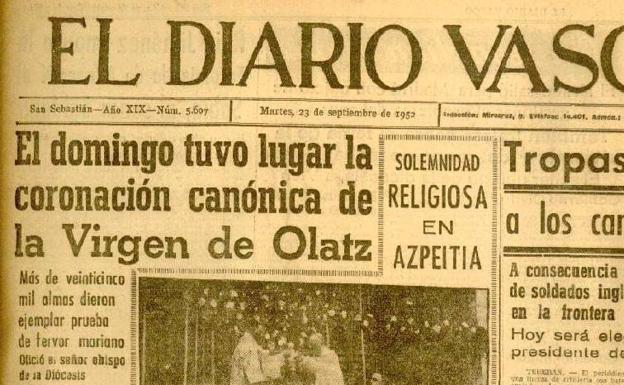The time Machine
Traveling to the Gipuzkoa of the past without leaving the newspaper library
The time machine takes us today to the coronation of a Gipuzkoan Virgin and the farewell of a San Sebastian cinema.
On September 14, 1952, the DV correspondent in Azpeitia, Elizburu, had reported a general mobilization in the town. “We know that the different streets and neighborhoods are working intensely (…). Until midnight the women of many streets are working making bows and garlands. This is admirable!”
What was happening? Well, the date of September 21 was approaching, in which Santa María de Olatz would be canonically crowned and chosen as the patron saint of all Azpeitiarras. Near the Loiola sanctuary, in the Izarraitz neighbourhood, the hermitage of the Virgen de Olatz was already an important place of worship. And more so in 1952, when her massive canonization was celebrated.
According to the headline of EL DIARIO VASCO in its edition of Tuesday 9-23-1952, «On Sunday the canonical coronation of the Virgin of Olatz took place. More than twenty-five thousand souls gave exemplary proof of Marian fervor. The Bishop of the Diocese officiated and the Bishop of Santander and Auxiliary of Zaragoza and our authorities attended.
“It is almost impossible to narrate the brilliance and emotion that the acts reached,” the correspondent warned. «Since the eve of such a solemn day, the influx of devotees of the Blessed Virgin, as well as innumerable Azpeitiarras who live outside the choco, has been animating our streets and giving color to an act that took on Sunday an extraordinary solemnity». In that Catholic mobilization, “the general communion masses celebrated in the parish church, starting at seven o’clock, were a continuous parade of faithful, with thousands of Gipuzkoans taking communion. It was the first beautiful act that gave a tonic of spirituality to the following ones».
At 10 in the morning, the pontifical mass was celebrated, presided over by Bishop Jaime Font Andreu, with the presence of political and military authorities of the time. After the Eucharist, as the correspondent reported, “the image of the Virgin of Olatz was taken to the Sanctuary of Loyola in an impressive procession, being received by the Community of the reverend Jesuit Fathers and singing a solemn Salve of welcome.”
«The staircase of the Basilica and the Ignatian temple were duly prepared for the acts, presenting an incomparable setting before a crowd that, after the transfer of the Virgin, began the parade to kiss the ribbons to the venerated image of Our Lady of Olatz ».
In the charitable style of that time, the Azpeitia City Council ordered an extraordinary lunch for the inmates at the Casa de Misericordia and distributed batches of food to 110 needy families.
diabolical movies
We make a compliment with the time machine from holiness to the diabolical, from 1952 to 1972, and from Azpeitia to San Sebastián. DV published on September 21, 1972 an advertisement for the Gaxen movie theater with the “program for the next and last ten days”. Below, in small print, could be read: «Gaxen, SA thanks all film fans for the attention they have given to our art and essay room and informs them of the closure of the premises due to the demolition of the Kursaal building».
The Gaxen room for ‘art and essay cinema’ was closing because the Great Kursaal in which it was located was going to pass away. He had a short life, just from January 2, 1969 to September 30, 1972, but his influence on the local cinephile was long.
The closing had his curiosity. The room was dedicated to Inesa de Gaxen, a heroine accused of witchcraft in Hondarribia. Well, during its last days in operation, the First National Congress of Brujology was held in San Sebastian. As a nod to that meeting, the room’s farewell cycle included films with witchcraft, hallucinations and demons: ‘The skin of satan’, ‘The mask of the devil’, ‘The seed of the devil’, ‘Repulsion’ and ‘Deus eo diabo na terra do sol’. They also programmed auteur tapes that had performed well during the room’s history: ‘The loneliness of the long-distance runner’, ‘The young Torless’, ‘To be or not to be’, ‘Alexander Nevski’ and ‘Hiroshima mon amour’ . Alain Resnais’ feature film ‘Hiroshima mon amour’ was the last one that could be seen at Gaxen, on 30-IX-1972. It was chosen because it was the same title with which it had opened.


